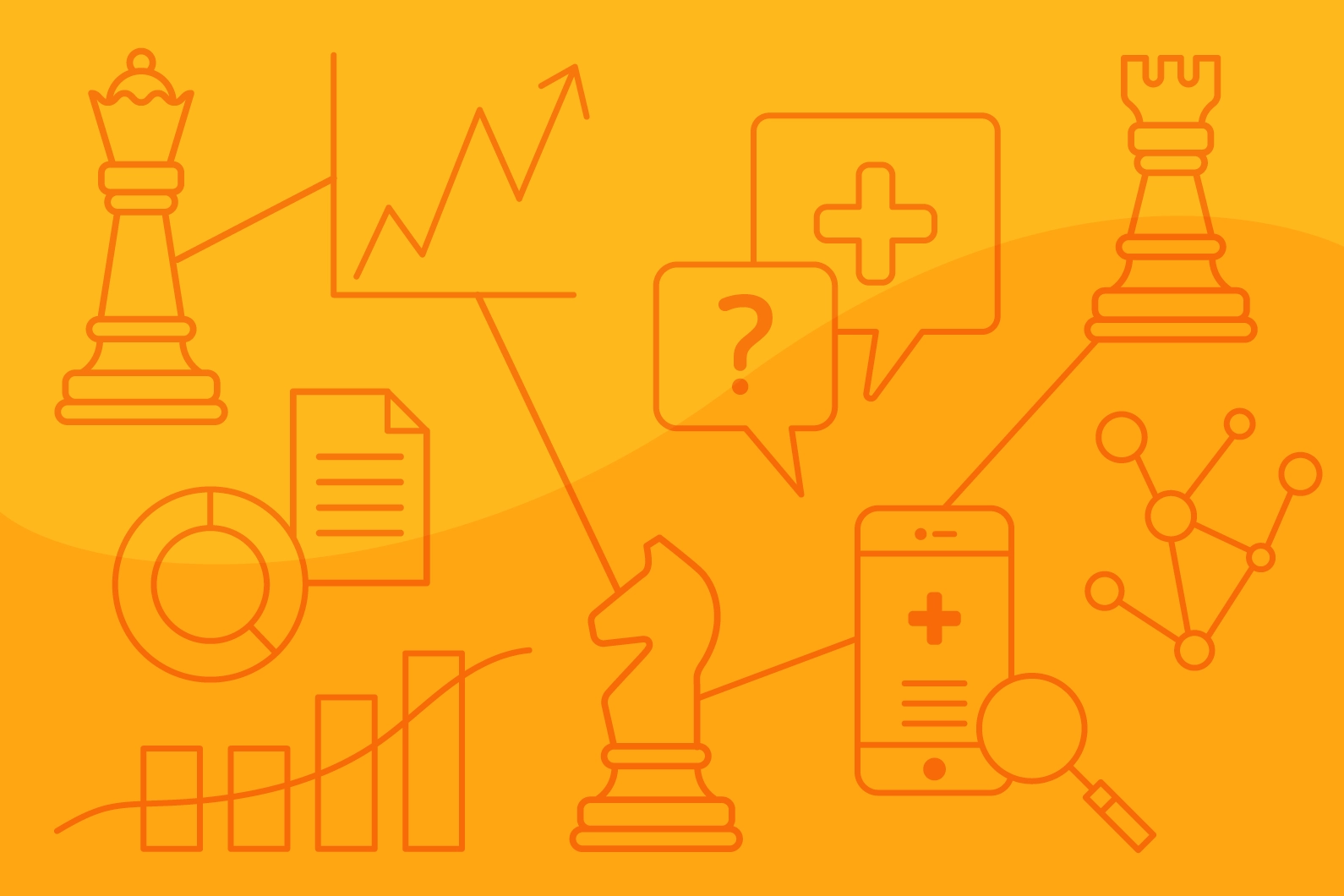Note: Grand Rounds Health is now Included Health
I grew up playing chess. I was never very good, and my younger brother would typically beat me, but that served as my motivation to keep trying to get better. Soon, the game began to shape the way I think and make decisions. “If I do this, then that is likely to happen, so then I will do this, and one of two things will happen, and in each of those situations I will do this…” For example, as an introvert, I gain courage before going into a nerve-wracking conversation by playing out the scenarios of how it may go in my head. As an over-planner, I think through every hiccup I may encounter on vacation and have all my contingency plans laid out in advance.
In the game of chess, the further you can go in anticipating the decision tree of likely moves, the better you are at the game. This is something that a computer excels at: it can process and store possible move trajectories to a much greater extent than a human. Recently, computer software has gotten even better. Rather than simply using brute force to compute all possibilities, it is “learning” what moves will lead to the best “outcome,” a checkmate. This starts by inputting the rules of play, and then allowing the software to compete against itself, such that, over time it discovers the logic that is associated with the highest probability of winning.
Working in the healthcare space, I have found that a similar type of logic helps describe a few key aspects of receiving care:
- Who needs care
- When does someone need care
- Where should someone seek care (which providers are of the most appropriate specialization, which providers have relevant experience, which providers deliver high quality care)
- What is the best clinical diagnosis and treatment decision
A patient’s journey as a tree of probabilistic events
A patient’s journey may be thought of as a tree of probabilistic events. I have control over what branch I choose to follow and can choose if and when to get care, who I go to first, and whether to follow my providers’ recommendations. But ultimately, I am not armed with the information I need to select my path.

The problems of chess and medical trajectories are similar. Both require enumerating possible pathways and selecting the optimal one. However, optimizing that journey in healthcare happens to be a lot more challenging.
| Chess | Healthcare |
|---|---|
| There are 32 pieces on a board and I know exactly what they are. | The average American does not know what all of the clinical specializations and sub-specializations are, and what types of symptoms are best treated by each. Do you know what a physiatrist is? In the above example, a physiatrist may be the best physician for me to go see. |
| I know that my next move comes after my opponent’s and understand that there are a finite range of moves to take. | My options are less clear. How do I know when my symptoms are bad enough to seek care? Will virtual care be a viable option, or do I need in-person care? Will I have access to the care I need, especially during this pandemic? |
| Chess pieces are rather trustworthy, each with a fixed way to move. | How do I know whether to trust my provider? Do they have the experience in seeing patients like me? What is their track record? Are they trying to make money, or do they really care about me? |
For my healthcare decisions, I feel like I am going in blind, but I still do need to choose a branch. The decisions I will make along this decision tree will impact my health outcomes, not only in the near-term but also in the future. Was I able to resolve my pain, avoid complications, maintain my quality of life, and minimize the cost spent on my care? Unlike a checkmate, the clearly optimal outcome, I will never know what the other branches would have yielded as I shape my healthcare journey, and whether I truly achieved the optimal outcome.

There is value in learning from past events
At Included Health, we are using technology (simulations, models, AI) to understand past patient trajectories in order to guide future ones. We take narrow groups of demographically- and clinically-similar members (cohorts), study what happens to them over time (care they receive or do not receive, type of care, quality of care, timing of care, symptoms and conditions they have or do not have, clinical events and episodes, etc.), and then compare their outcomes (complications, readmissions, mortality, spend, etc.). Each part of this optimization problem is a modeling effort: how do you define similar cohorts, how do you assess and align patient risk, how do you quantify an outcome, how do you define a clinical episode? We partner closely with our in-house clinical team on our models as proper representation of medical knowledge in our parameterization, assumptions, and analysis is essential. Once we have all of the inputs in place, we try to discover or “learn” the patterns that manifest in better outcomes. And once we understand this, we can help guide a similar group of patients down the type of path that will yield better outcomes.
For example, we use insights gained from historical data to:
- Understand differences in provider practice patterns (safety, effectiveness, cost efficiency, etc.) for narrow patient cohorts, and how those differences manifest in differing clinical and financial outcomes.
- Discover how differing care paths lead to different outcomes amongst narrowly-cohorted patients. We identify the nodes where these paths diverged to inform us on the types of interventions that can lead similar patients towards better outcomes.
- Predict how to best navigate our members through the Included Health ecosystem of services such that our care and clinical staff can best assist and treat our members.
The problem can be framed to optimize a patient’s journey
Our goal is to meaningfully optimize a patient’s journey to get them to the best possible outcome. We do this by applying the data and modeling insights described above, along with our collection of illustrative data, a powerful data platform, and tools to scale our work. Collectively, these efforts help us determine who we should help, when we should help, and how we should help. Even if it is not this conclusive, (because no probabilistic model ever is), we know the options and know the narrative of what may happen downstream of choosing those options… and then strive to explain this to our members with more clarity and information typically available to them.
What’s next?
Today, our data science and machine learning team is focused on the who, when, and where, and not yet on the what. Using the power of technology, we aim to get you to the best possible provider for your care when you need it (be it an Included Health clinician or external provider), and we then trust that they will be able to effectively diagnose and make decisions about the best treatment path. There is so much nuance and variation from individual to individual, that we are not in a place where we can replace human judgement for an individual’s final health decisions. However, getting to the who, when, and where, using the power of machine learned models and simulations, we are leaps and bounds ahead of where the healthcare system used to be, and in just those three areas, we still have a long way to go to take full advantage of technology’s power.
But imagine we were there. That we had a perfect charting of every possible medical trajectory, all possible scenarios branched out from all possible patient types, and we could determine the optimal path for every patient scenario — the Deep Blue Plus of medicine. How could we surface our knowledge graph and patient information to providers such that they could use our decision tree along with their intuition to treat patients and get them to optimal outcomes? How much further could we progress with our modeling such that we could remove data collection, logistics, and simple cases from a provider’s day-to-day to support them in using their time more efficiently, focusing on their area of expertise? Just how far can we push on making our healthcare system easier, faster, more understandable, and more cost efficient while enhancing clinical outcomes?
Machines change the culture of chess. Chess turns from a battle of wits, a contest of who can foresee more and make the best decisions (a true game!) to something that moves closer and closer to being “solved.” Healthcare navigation and decision making is a much more difficult map to solve… no distinct boundaries of the board, no finite number of squares, no fixed patterns of how pieces move. And yet our health really should not be something that feels like a game. It should not be left to the chance of us understanding the system, having the right access, or making the right (under-informed) decisions. It is a space where we could use a lot more innovation — so I’d love to hear your thoughts. How might you use the machine to better understand the massive tree of possible trajectories in healthcare?
Note on Data Use: We generally use the minimum necessary de-identified data to derive insights, and these insights are presented only to the treating professionals.
Does this sound interesting to you? Are you up for the challenge of using data to get everyone to the best possible health outcome? If so, check out our health tech open roles and apply today.

About the author

Jayodita Sanghvi
Jayodita is a Data Science Manager at Included Health. She works on patient and provider analytics that help ensure patients are routed to the best possible care. Prior to Grand Rounds (Included Health), Jayodita received a BS in Biology from the Massachusetts Institute of Technology. She then moved to Stanford University for her MS and PhD in Bioengineering and worked on the first gene-complete simulation of a living cell. Her work on simulating all of the inner workings of a bacterial cell has been published in Cell, Nature Methods, The New York Times, and other outlets. She did her postdoctoral studies at the University of California, Berkeley, where she built simulations of HIV infecting human T cells. Her interests in large-scale computing and large biological datasets brought her to Included Health, where she explores massive clinical datasets to benefit human health.



